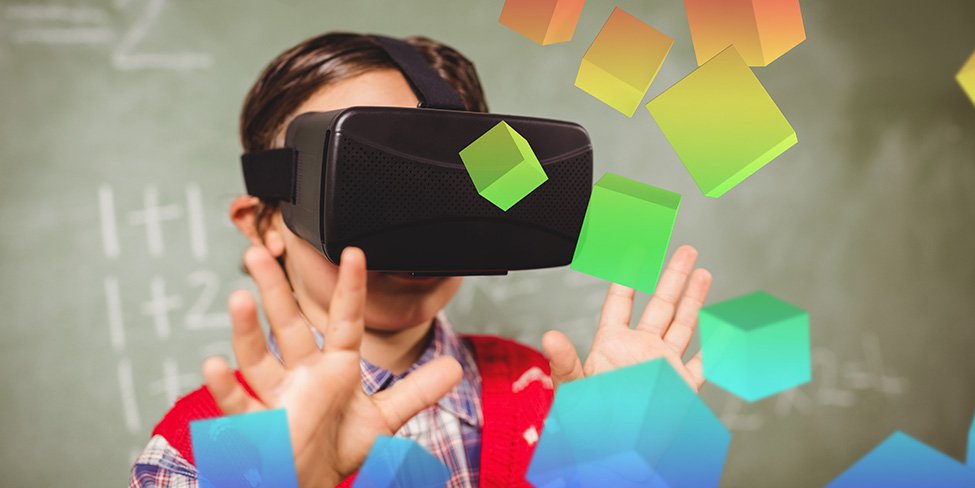Ever since virtual reality (VR) and augmented reality (AR) introduced to education as the latest in digital curriculum tools, their visual appeal has been clear, but the big question has always been, “Do they improve teaching and learning?” According to a couple of different sources, the answer to that question is a resounding “yes.” For example, in a survey conducted by Samsung, 85% of teachers agreed that VR will have a positive effect on students and 68% of teachers said they want to use VR to supplement course curriculum to help students better understand course concepts.
In a panel at ISTE called "Virtual Reality: Blend This Into Your Learning," Free Tech 4 Teachers founder Richard Byrne summarized the challenge of transforming VR from a novelty to a dependable teaching tool. “We can get kids engaged in a lot of things very quickly, with that ‘cool factor,’ he said. “The long-term engagement is more of a struggle. Once that initial ‘cool factor’ wears off, then we have to look at what we can do to continue to engage kids in using the technology in the classroom." Here’s where VR and AR’s immersive, user-driven nature kicks in: What better way to get students engaged than to put them at the center of their own virtual world? Here are stories from two educators who have done just that.
Leah LaCrosse, Science Teacher
In my 8th-grade science class, I use the Lifeliqe app to highlight concepts that are somewhat difficult to grasp. I use the app while projecting up to the big screen, or I work with individual students/small groups. This alternate view of the concept is a great way to give students a different perspective on the science.
For example, while studying earth structures, it was very helpful for students to view and manipulate these gorgeous models of continental plate boundaries, convergent and divergent boundaries, and faults. We also segmented models to see specific features. We used Play-Doh modeling while exploring the app models to simulate the movement and provide a matching, hands-on experience.
During our genetics unit, I was able to work with small groups to give students a perspective of DNA with the Lifeliqe model. I also loved the ability to explore the International Space Station with small groups of students who were researching the ISS at the end of the year. The model was a perfect way for them to understand the cumulative effort it took to build the space station.
In my classroom, VR provides visual support for difficult science content, and the ease of use makes it a resource that I didn’t have to prep the students for. The first time we used Lifeliqe, my students were instantly intrigued about “what else” they could find. They wanted to go through every category
Our students operate in a visual/auditory world, and simple text-type science is just not enough. VR gives them perspective and insight that was not available before. I can hear a greater understanding in their discussions with each other and myself about the science. Any tool that is going to allow students to become better science communicators is a winner in my classroom.
Michelle Zimmerman, PhD, Director of Teaching and Learning Sciences
We first used AR for project-based blended learning combining science, technology, engineering, arts, mathematics, and literature. The Sherlock Holmes mystery novel The Hound of the Baskervilles became the hub of the learning. One character is a botanist and Sherlock Holmes is known for looking at details to solve the unknown, so we used jeweler’s loupes to magnify leaves to investigate in real life. Students drew what they saw and then wrote analogies for what it looked like magnified. Then they collaboratively wrote poems. Then, using Lifeliqe’s Deep Zoom feature with a tree model, we were able to zoom into a leaf to see the internal structure. That connected learning to biology at a cellular level, beyond the magnification they could see with their eyes.
In another instance, students in middle school were learning the anatomy and physiology of the human heart. They used Lifeliqe’s model to help show 2nd -grade students the details of the heart. They used the “highlight” function on the AR model to help focus the younger kids’ attention on specific elements or features, and rotated images in space to explore volume, dimension, and space.
The middle schoolers helped the 2nd-grade class create a research project based on their learning, pulling in clips from Discovery Education, then screen-recording and using digital cameras to record. They helped the younger kids create a presentation in PowerPoint, make audio recordings of their understanding, include 3D digital objects to illustrate their learning, and use AR to demonstrate how heart works in the human body.
Virtual reality and augmented reality are quickly changing the way people learn, and using these cutting-edge tools motivated them to create the best digital artifact possible, and they wanted to share it with others. And in fact my students have presented at multiple professional conferences using 3D images, and it has impressed adults.
More importantly, using these technologies have created a different level of student engagement, especially with cross-age mentoring. It showed that students can learn much more complex topics, tasks, and features at younger ages than many educators think is possible. The vocabulary and all the technical features don’t need to be presented in their entirety to younger children before they can immerse themselves in objects and experiences.
Leah LaCrosse, an 8th-grade science teacher at McCormick Junior High in Huron, OH, is an Apple Distinguished Educator and a National Board Certified Teacher. Follow her on Twitter @LLacrosse.
Michelle Zimmerman, PhD, is the Director of Teaching and Learning Sciences at Renton Prep in Renton, WA. She is a Microsoft Innovative Educator Expert and Lead PBS LearningMedia Digital Innovator, and was the NCCE 2016 Outstanding Technology Educator of the Year. Follow her on Twitter @mrzphd.











